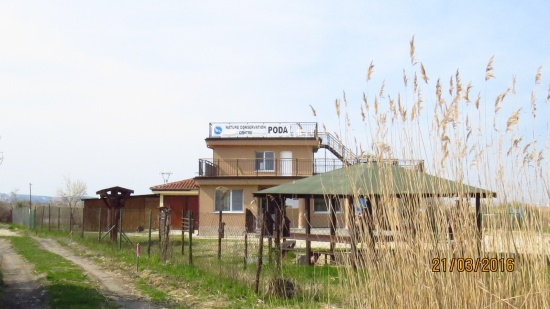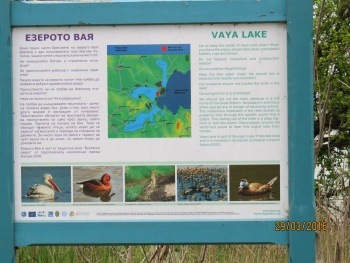| This article is incomplete. This article is missing one or more sections. You can help the BirdForum Opus by expanding it. |
Overview
This site, or rather, group of sites, is situated on the central Black Sea coast of Bulgaria and is one of the best areas for waterfowl in the country despite having suffered from serious habitat loss in recent decades.
The main habitat consists of four lakes, Burgas, with extensive reedbeds, Mandra, now a reservoir, Poda, a brackish lagoon, and Atanasovo which, despite much industrialisation and now being little more than a series of salt pans, is now a Ramsar Site.
Birds
Notable Species
The area attracts a range of birds at all seasons with some rare breeding species including Little Bittern and several heron species, Ferruginous Duck and Gull-billed Tern with Pygmy Cormorant and Glossy Ibis formerly breeding at Lake Mandra.
Passage periods can be excellent with numerous pelicans, mainly Great White Pelican but Dalmatian Pelican regular in small numbers, both storks, Glossy Ibis and Eurasian Spoonbill. Raptor passage is also impressive with European Honey Buzzard and Lesser Spotted Eagle the most numerous and small numbers of Levant Sparrowhawk, Booted Eagle and Steppe Eagle. Greater Spotted Eagle and Eastern Imperial Eagle are regular on passage in very small numbers. Waders often include Temminck's Stint and Marsh Sandpiper.
Open agricultural country around the lakes has Long-legged Buzzard and Northern Hobby, European Roller and various larks and warblers. In winter the lakes attract Bewick's Swan and Whooper Swan, geese and various ducks usually included a small number of White-headed Duck. Red-breasted Goose occurs in variable numbers in winter.
Lake Burgas
All the lakes lie close to the town of Burgas which has an airport. The E87 coast road follows the eastern edge of Lake Burgas, also known as Vaya, and there is access to the shore at several points.
One of the better areas of this brackish lake is the western shore between the villages of Gorno Ezerovo and Dolno Ezerovo. There are also some abandoned fishponds in this area and a working fishfarm close to Dolno Ezevero where birders are generally welcomed. Great Cormorant breeds at Lake Burgas and although Pygmy Cormorant may be seen it does not nest. Similarly Great White Pelican is often present but does not breed here. Both bitterns occur as well as Squacco Heron, Black-crowned Night Heron and Purple Heron, Great White Egret, Little Egret and Western Cattle Egret, Eurasian Spoonbill and Glossy Ibis.
Waterfowl include Ruddy Shelduck, Garganey and sometimes Ferruginous Duck, Corn Crake and Little Crake are present in summer but as always remain very difficult to see well.
The well-vegetated lake margins have breeding warblers including Cetti's Warbler, Savi's Warbler, Common Reed Warbler, Great Reed Warbler and Marsh Warbler, Penduline Tit nests in the area as does Syrian Woodpecker. Black-throated Diver, Red-breasted Goose and White-tailed Eagle are often present in winter.
Atanasovo
Atanasovo is a shallow coastal lagoon heavily utilised for salt production that lies about 3km to the north-east of the town of Burgas. Around the lake there are freshwater marshes and a canal, wet meadows and drier farmland as well as the Black Sea coast. Despite its very industrial appearance Lake Atanasovo often has the best birds in the Burgas area and access is easy as the E87 passes through the middle of the salt pans.
Part of the northern shore is a reserve which requires a permit to visit and also the part of the lake south of the road. One of the most productive areas can be reached by following the asphalt road on the eastern side of the northern half of the lake towards the airfield. Turn left by the airfield and walk towards the lake across open fields and past ponds and reedbeds.
More than 250 species have been recorded at Lake Atanasovo with breeders including Little Bittern and Purple Heron, Black-winged Stilt and Pied Avocet, Collared Pratincole and Mediterranean Gull and Gull-billed Tern, Sandwich Tern and Little Tern.
Often present in summer but as non-breeders are Pygmy Cormorant, Glossy Ibis and Eurasian Spoonbill, Slender-billed Gull and Caspian Tern.
The range of birds seen here during passage periods is astounding. Both pelicans and both storks, herons and waterfowl including swans, raptors, including most of the European migratory species, virtually all the wader species including Red-necked Phalarope and even Slender-billed Curlew at times and various gulls and terns. European Bee-eater, European Roller and Eurasian Hoopoe are regular migrants and passerines can include Thrush Nightingale, Isabelline Wheatear and sometimes Aquatic Warbler. The variety and numbers of breeding birds in particular has declined over recent decades but there is still much of interest for the visiting birder.
Poda Lagoon
The Poda Lagoon area has an excellent reputation for passage waders and consists of a the coastal lagoon itself, a rivermouth and various small waterbodies of varying salinity. These are surrounded by grassland, scrub and woodlands on the southern edge of Burgas reached on the E87 heading for Sozopol.
The reserve here has an information centre. Pygmy Cormorant and Glossy Ibis have bred at Poda and Little Bittern, Little Egret and Eurasian Spoonbill are regular. Also breeding are Black-winged Stilt, Pied Avocet and Collared Pratincole, and Common Tern and Little Tern.
Passage periods bring a wide range of birds to the area including divers and grebes, pelicans, storks and herons, waterfowl and raptors. Migrant waders include Little Stint, Great Snipe, Broad-billed Sandpiper and Marsh Sandpiper and many commoner species, Marsh terns are common on passage, skuas occur and gulls include Slender-billed Gull and Mediterranean Gull.
Mandra
Mandra is the southernmost of the four lakes and lies south of Burgas to the west of the E87.
Now a reservoir, Mandra is a large freshwater lake with dense marginal vegetation in parts and surrounded by farmland except to the south where woodland reaches the shore. It can be viewed from many points reached from the E87, the road to Sredetz or the road to Tvarditza. The reserve is some marshland about 2km west of Tvarditza. The breeding and passage birds are much the same as the other lakes in the area.
Rarities
Rarities recorded in this area include Slender-billed Curlew (though none for some years now), Pallas's Gull, Saker Falcon, and recently, the first Yellow-billed Stork for Bulgaria. Rose-coloured Starling bred in large numbers in the area in 2000 but this is an irregular species.
Check-list
Birds you can see here include:
Red-throated Diver, Black-throated Diver, Little Grebe, Great Crested Grebe, Red-necked Grebe, Black-necked Grebe, Slavonian Grebe, Great Cormorant, Pygmy Cormorant, Dalmatian Pelican, Great White Pelican, Great Bittern, Little Bittern, Black-crowned Night Heron, Squacco Heron, Western Cattle Egret, Little Egret, Great White Egret, Grey Heron, Purple Heron, Black Stork, White Stork, Glossy Ibis, Eurasian Spoonbill, Mute Swan, Bewick's Swan, Whooper Swan, Greater White-fronted Goose, Greylag Goose, Red-breasted Goose, Ruddy Shelduck, Common Shelduck, Gadwall, Mallard, Garganey, Northern Shoveler, Common Pochard, Tufted Duck, Ferruginous Duck, Common Goldeneye, Smew, White-headed Duck, European Honey Buzzard, Black Kite, White-tailed Eagle, Short-toed Eagle, Western Marsh Harrier, Hen Harrier, Pallid Harrier, Montagu's Harrier, Levant Sparrowhawk, Eurasian Sparrowhawk, Eurasian Goshawk, Common Buzzard, Long-legged Buzzard, Lesser Spotted Eagle, Greater Spotted Eagle, Steppe Eagle, Eastern Imperial Eagle, Booted Eagle, Osprey, Lesser Kestrel, Common Kestrel, Red-footed Falcon, Merlin, Northern Hobby, Saker Falcon, Grey Partridge, Water Rail, Spotted Crake, Little Crake, Corn Crake, Common Moorhen, Eurasian Coot, Common Crane, Black-winged Stilt, Pied Avocet, Stone-curlew, Collared Pratincole, Little Ringed Plover, Kentish Plover, European Golden Plover, Grey Plover, Sanderling, Little Stint, Curlew Sandpiper, Dunlin, Broad-billed Sandpiper, Ruff, Jack Snipe, Great Snipe, Black-tailed Godwit, Bar-tailed Godwit, Whimbrel, Slender-billed Curlew, Eurasian Curlew, Spotted Redshank, Common Redshank, Common Greenshank, Marsh Sandpiper, Green Sandpiper, Wood Sandpiper, Common Sandpiper, Ruddy Turnstone, Red-necked Phalarope, Pomarine Skua, Arctic Skua, Little Gull, Mediterranean Gull, Black-headed Gull, Slender-billed Gull, Yellow-legged Gull, Gull-billed Tern, Caspian Tern, Sandwich Tern, Common Tern, Little Tern, Whiskered Tern, White-winged Tern, Black Tern, Western Barn Owl, Short-eared Owl, Common Kingfisher, European Bee-eater, European Roller, Eurasian Hoopoe, Syrian Woodpecker, Calandra Lark, Greater Short-toed Lark, Wood Lark, Barn Swallow, Tawny Pipit, Black-headed Wagtail, Bluethroat, Thrush Nightingale, Isabelline Wheatear, Cetti's Warbler, Savi's Warbler, Eurasian River Warbler, Aquatic Warbler, Marsh Warbler, Common Reed Warbler, Great Reed Warbler, Eastern Olivaceous Warbler, Olive-tree Warbler, Barred Warbler, Spotted Flycatcher, Bearded Tit, Penduline Tit, Red-backed Shrike, Lesser Grey Shrike, Woodchat Shrike, Rose-coloured Starling, Spanish Sparrow, Cirl Bunting, Black-headed Bunting, Corn Bunting
Other Wildlife
To do
Site Information
History and Use
To do
Areas of Interest
To do
Access and Facilities
All four lakes are within easy reach of the town of Burgas where a range of accommodation can be found.
Contact Details
To do
External Links
Content and images originally posted by Steve







